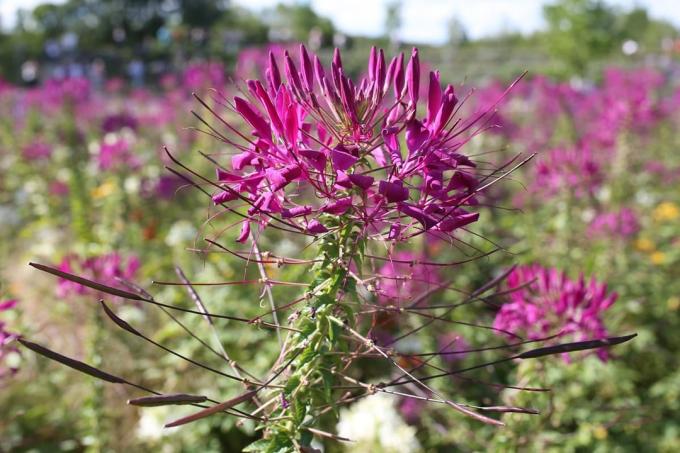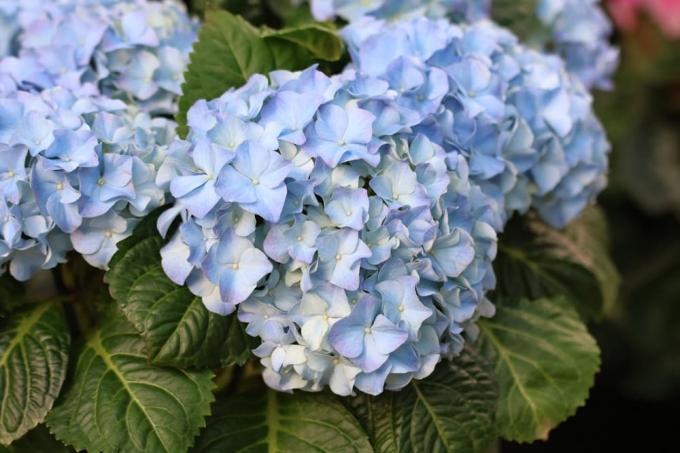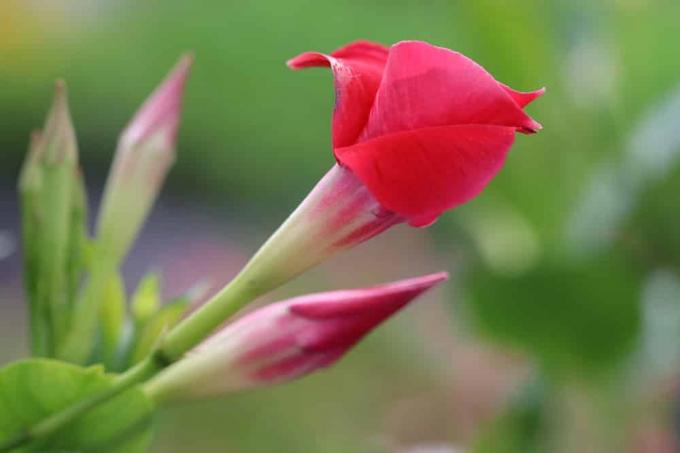

Table of contents
- Characteristics
- Location
- substrate
- sowing
- pricking
- plant out
- Pour
- fertilization
- seed
- pruning
- wintering
- Diseases
- pests
- use
From late summer, the spider flower conjures up a filigree lightness in the flower bed. The spider plant is cultivated as an annual and you can propagate it yourself by sowing. It is not hardy and is usually not overwintered because it is easy to propagate.
Characteristics
- botanical name: Cleome hassleriana (most common species)
- Family: Cleomaceae
- Flower colors: violet, pink
- Flowering period: July - October
- Growth height: 80 - 100 cm
- Origin: South America (mainly Bolivia, Brazil, Argentina, Paraguay)
- toxic to humans and animals
- around 300 different species
- popular varieties: SENORITA ROSALITA, FESCHE FANNY
- Inflorescences with thorns
Location
Spider flowers prefer a spot in full sun that is sheltered from the wind. It can also be grown in semi-shade, but at the expense of flowering. Spider plants fit very well in the perennial border, but should be in the back rows due to their size.
The following plants are suitable as direct neighbors in the perennial bed:
- Larkspurs
- marigolds
- torch lilies
- jewelry basket
- grasses
The spider flower can also be grown in a pot or be cultivated in tubs. It should then also be sheltered from the wind and in full sun on the balcony or terrace.
substrate
The spider plant likes nutrient-rich soil, but it must be permeable. You can mix garden soil with compost or horn shavings to give the plants a good base. If your garden soil is prone to waterlogging, work sand into the soil as drainage.

A notice:
Normal potting soil is sufficient for a culture in a bucket. It no longer needs to be upgraded with additional fertilizer.
sowing
Spider flowers are light germinators. You can prefer the plants or you can scatter the seeds directly in the bed. The spider flower blooms much earlier if you prefer it protected. Start sowing in March at the latest.
Instructions for sowing:
- Fill the seed tray with seed soil
- moisten soil
- Distribute seeds evenly
- Press seeds lightly
Moistening the soil beforehand will prevent the seeds from being covered by soil that becomes bloated. Cover the seeds with a transparent hood. This will prevent the soil from drying out quickly. During the germination period, the seeds must remain constantly moist.
A notice:
When sowing, the temperatures should be at least 18 – 20°C. Place the seed tray on a south-facing window to give the seeds enough light.
pricking
The germination of the spider flower is very fast. After a few days, the cotyledons will appear. As soon as the young plants have reached a height of six to eight centimetres, you can separate them. This promotes root formation and strong plants grow.
Use a mixture of seed and potting soil as substrate. The substrate should be richer in nutrients, but not immediately too rich. This stimulates the formation of roots.
plant out
The spider plant is not hardy. The plants that have been brought forward can therefore be outdoors in mid-May at the earliest, when there is no longer any danger of frost. The spider flowers are usually planted in groups, which gives them a better visual impact. However, make sure that the planting distance is at least 40 cm. This prevents the plants from having to compete for light and nutrients.

In the first time after planting out, make sure that the plants are sufficiently supplied with water. Once the spider flowers are rooted, you can easily reduce the watering amounts.
Tip:
Give the spider flowers a plant stick right away. They break off easily and heavy rain can topple the plants.
Pour
The spider plant tolerates short periods of drought well. However, this should remain the exception, because so that the plants can develop well, they should be supplied with water regularly. Avoid soil that is too wet and always water moderately.
Especially in the hot summer months, the plants need an adequate water supply. Always water close to the ground and avoid getting the leaves and flowers wet. Regardless of whether you cultivate the spider flower in a bed outdoors or in a pot, make sure that it does not become waterlogged.
fertilization
Spider flowers need a regular supply of nutrients. In addition to basic fertilization before planting, you should add liquid fertilizer to the irrigation water. Water with liquid fertilizer every two to three weeks. Fertilization is maintained constantly until autumn, when the plants have died from frost.
Commercially available fertilizer for flowering plants is suitable as a liquid fertilizer. You can also use nettle manure that you have prepared yourself for fertilization. It also has the advantage that you can use it to prevent pests to which the spider plant is susceptible.
Prepare nettle manure:
- Roughly chop the cabbage
- Fill the bucket 2/3 full with cabbage
- fill up with water
- stir regularly
As soon as most of the herb has decomposed, you can add the liquid manure to the irrigation water in a ratio of 1:10.
seed
Spider flowers are rarely commercially available as preferred plants, but only as seeds. Once you have spider flowers in the garden, you can collect seeds yourself. You can collect the ripe pods from around August. You can also just let the seeds fall out, they can overwinter compared to the plants outdoors. The seeds will germinate in the bed if the temperature is constantly above 18°C.
pruning
Spider plants do not need pruning. However, it is beneficial if you regularly remove wilted leaves and faded inflorescences. Even if you want to get seeds, limit it to a few buds that you let mature. This keeps the spider flowers blooming.

wintering
It is not necessary to overwinter the spider plant. Attempts to hibernate them mostly fail because the plants don't get enough light. The effort to overwinter them is also disproportionately large, which is why it makes more sense to collect seeds until autumn and use them again for sowing.
Diseases
A disease resulting from an error in care is root rot. The roots die off from too much moisture, which prevents the plants from absorbing water and nutrients. As a result, the entire plant dies. Plants in pots are particularly affected. Simply prevent root rot by watering moderately. If water builds up in the coaster, pour it out.
pests
Occasionally leave on the spider plants aphids low. You can prevent an infestation by fertilizing with nettle manure. You can also shower the plants in this case so that the aphids are washed off. Encouraging predators also helps in the fight against aphids.
Spider plants have a natural repellent due to their toxic ingredients, which means that aphids are rather rare. This also applies to snails, which rarely eat the plants. Only when food is scarce do they go to the spider plant.
A problem can vine weevil become. They eat both the leaves and the roots. Especially larvae on the roots usually mean the death of the plants. To prevent this from happening, check regularly for damage caused by feeding on the leaves. If there are indentations, check the roots. If larvae have settled there, you can fight them with nematodes that you add to the irrigation water.
use
The spider flowers are ideal for making beds in very sunny places. They do well in locations where other plants have problems due to drought and heat. The spider plant is suitable as a group plant, but she also does as specimen plant cut a fine figure in a pot or as a border, for example at driveways.

Spider flowers are also ideal as annuals underplanting in summer. It can shade many plants, such as roses, on the ground, preventing other plants from suffering from the heat. In addition, it is not particularly attractive to most pests, which means that it can also be used for pest control itself.
Due to the fact that it is not hardy, it hardly does any work after the first frost. The leftovers are simply disposed of on the compost and your beds are already cleared.
The spider flower is only suitable to a limited extent cut flower. It should be placed in water immediately after cutting, otherwise it will wilt. Due to the toxic ingredients, it does not get along with other plants in the vase.
 garden editorial
garden editorial I write about everything that interests me in my garden.
Learn more about potted plants

How do I care for a gentian tree? Lycianthes rantonnetii
A gentian tree can be a decorative enrichment both on the balcony and in the garden. For the culture, however, some criteria must be observed. This includes, among other things, the high nutrient content that is required for flowering.

Overwinter pampas grass | 16 tips for winterizing
Pampas grass is a popular ornamental plant in the garden or in tubs, which can be attractively integrated into a wide variety of garden ideas thanks to its decorative fronds. They are considered hardy, but need suitable winter protection in Central Europe due to possible moisture damage.

Leadwort, plumbago: care from A to Z
Leadwort (Plumbago) hides one of the most attractive potted plants of all. The magnificent shrub impresses above all with its blue flowers, which it produces from May to autumn, transforming terraces and balconies into a luminous oasis.

Hydrangeas, rhododendrons and hibiscus smoke | dangers of drugs
Anyone who has cultivated hydrangeas, rhododendrons or hibiscus in the front yard may be surprised that the beautiful flowers were cut off by strangers. Because especially among young people, there is a rumor that these flowers can be smoked and have the effect of marijuana. But this is dangerous information.

Peasant hydrangea, Hydrangea macrophylla - care and pruning
With its attractive, ball-shaped umbels of flowers in white, pink, purple, red or blue, the hydrangea is one of the most decorative garden plants. Here's what you need to know about the farmer's hydrangea so that it blooms and thrives lushly in your garden.

Dipladenia 'Sundaville red' - Caring for the Mandevilla as a houseplant
With its bright red, trumpet-shaped flowers, Dipladenia 'Sundaville red' - which is a hybrid of the tropical Mandeville or Mandevilla is a beautiful eye-catcher on the balcony or terrace. However, the climbing plant can also be easily maintained in the living room.



